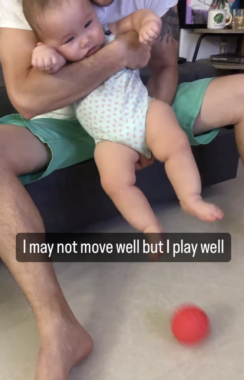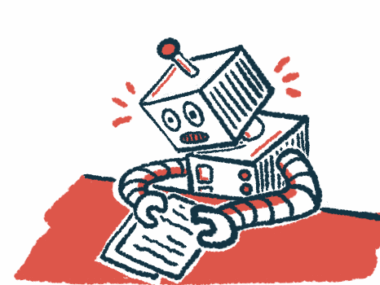As AADC deficiency parents, we often felt like puppeteers
How we manipulated our daughter's body before she could move on her own
Written by |

A notification pops up on my phone. It’s from Facebook, sharing a memory from five years ago. The clip shows me holding my daughter, Rylae-Ann, who’s playing with a ball. However, I acted as a puppeteer because she couldn’t move her limbs, and there was no indication she’d ever be able to do so. Yet we played because I believed there was an unknown path to a future where she could move.
After children with aromatic l-amino acid decarboxylase (AADC) deficiency are born, one of the first symptoms parents notice is that they stop meeting developmental milestones at about 3 months old. When I meet with other AADC deficiency parents, I use the term “puppeteer” to explain how to enhance our children’s playtime. I mean it in the most endearing way, and I feel it helps to explain the process.
AADC-deficient infants cannot support their heads, don’t reach out and grab, and can’t do belly time. This is extremely alarming to new parents who are expecting all the joys of playing with their child.
Taking Rylae-Ann through the motions
When my wife, Judy, and I realized something was wrong with Rylae-Ann, parental and teacher intuition began to kick in. As we embarked on a diagnostic odyssey to learn what our daughter had, at the same time, we began to do some intervention. There were no books to guide us or experts to tell us what to do. We could only proceed with what we felt in our hearts.
I believe the act of manipulating our daughter’s body so she could still participate in life proved to be a key factor in her success later on. We were motivated to find a different path to achieve future movement. Although Rylae-Ann couldn’t move on her own, it didn’t mean she had to only watch the world move. Judy and I often talked about how our daughter’s eyes conveyed how badly she wanted to move, despite not having the muscles to move or even talk.
Throughout every day, we controlled Rylae-Ann’s body for her. When we woke up, we used her hands to turn on the light switch. During feedings, we supported her hands to hold the spoon and manipulated her body so she would feel and see her hands bring the food to her mouth. When changing clothes, we allowed her to experience the motions.

Richard holds his daughter, Rylae-Ann, and moves her legs to kick a ball so she can play. (Courtesy of Richard E. Poulin III)
Most importantly, we played as a family. Judy would roll the ball while I helped Rylae-Ann return a kick. While Judy played songs and sang, I sat behind Rylae-Ann to support her in a seated position and helped her clap along with the songs.
This was the routine and lifestyle we adopted. We were the puppeteers as much as possible. There was no parent guidebook telling us that this would result in progress. In fact, it’s more likely that parents would feel it’s a hopeless process. You will not see drastic signs of improvement. Onlookers may see only a floppy child with no hope. Also, it is physically exhausting to be a puppeteer.
However, after Rylae-Ann had gene therapy, progress happened quickly. We believe she knew what was supposed to happen with her body and now finally had the ability to complete those motions. She still had a long road of physical therapy ahead, but I believe that being a puppeteer for her before gene therapy gave her a head start on recovery.
Note: AADC News is strictly a news and information website about the disease. It does not provide medical advice, diagnosis, or treatment. This content is not intended to be a substitute for professional medical advice, diagnosis, or treatment. Always seek the advice of your physician or other qualified health provider with any questions you may have regarding a medical condition. Never disregard professional medical advice or delay in seeking it because of something you have read on this website. The opinions expressed in this column are not those of AADC News or its parent company, Bionews, and are intended to spark discussion about issues pertaining to aromatic l-amino acid decarboxylase deficiency.






Leave a comment
Fill in the required fields to post. Your email address will not be published.